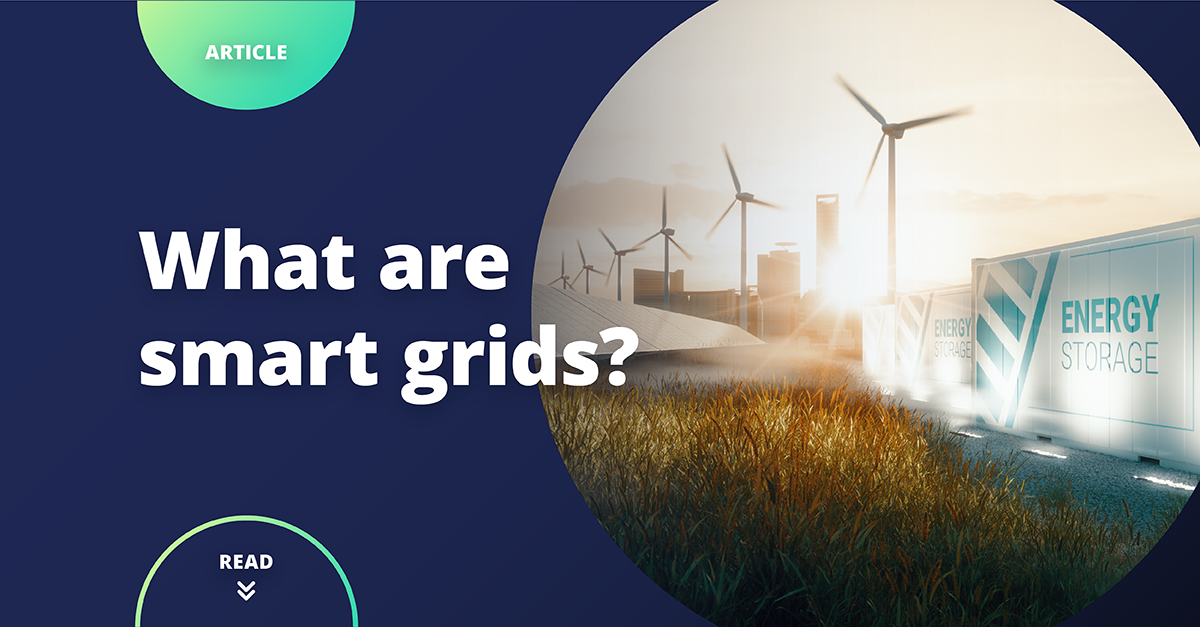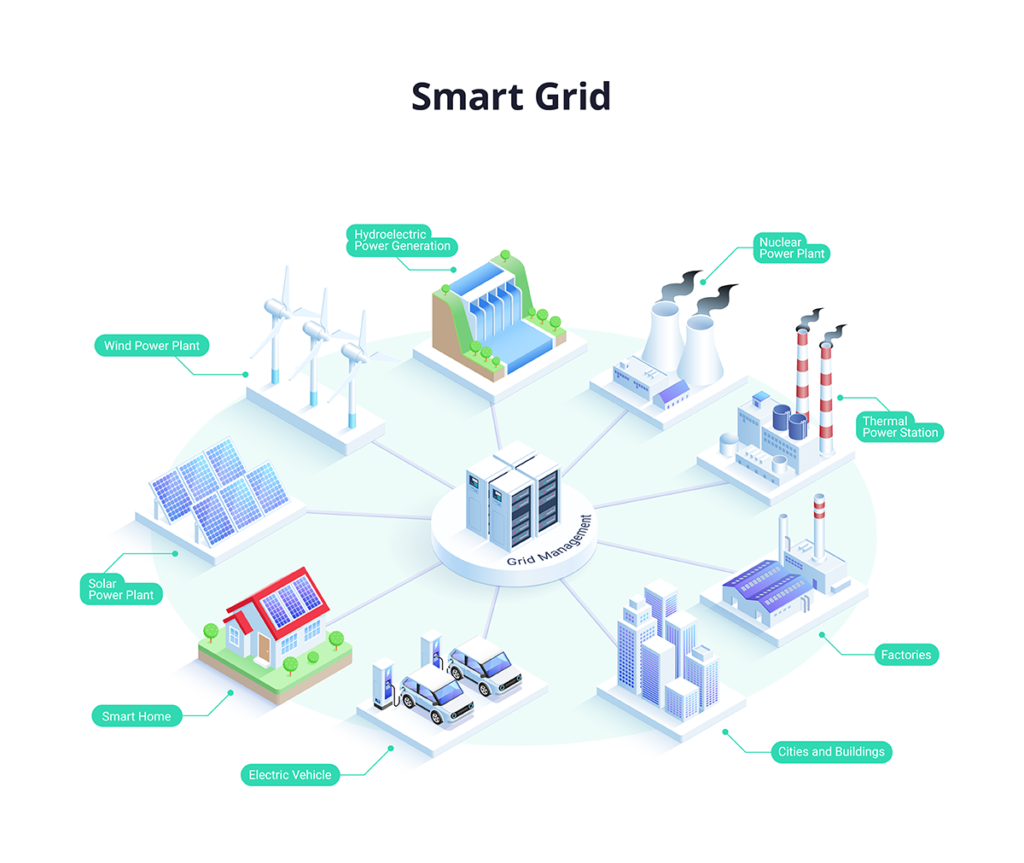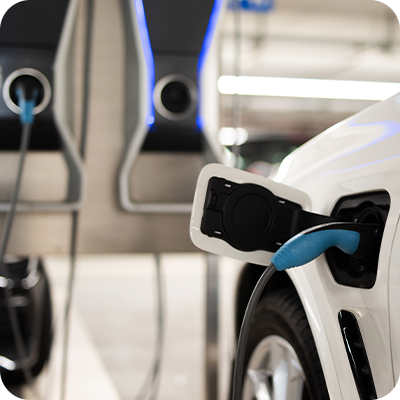What are smart grids?

It’s hard to imagine our world now without the electric grid network that keeps our houses and workplaces supplied with electricity. However, the conventional electric grids, as we know, are getting old – and inefficient. They can barely handle the growing number of devices that need electricity to function, are prone to outages that can turn into widespread blackouts, and the cost of repairing the lines is only growing.
Smart grids could be a solution to all those problems though, so both energy suppliers and consumers are looking with growing interest at those.
What are smart grids, and what exactly makes them “smart”? Let’s have a look.
What Is a Smart Grid?

Smart power grids simply refer to electrical grids powered with modern technologies, such as big data, sensors, wireless modules, and monitoring systems to make the grids more efficient and resilient.
The biggest difference from regular grids is that intelligent grids can collect real-time information on electricity consumption, demand, and any issues spotted in the grid and then send the information to suppliers and consumers. Through the sensors, the grid can also monitor the activities of all devices connected to the grind and even give suggestions to consumers on how they can use their energy more efficiently.
Not only can this make more consumers aware of how much energy they are using, but also alert them to any issue or malfunction that could cause a power outage.
But Smart Power Grids also come with a few more useful features:
- Self-healing (isolating all malfunctioning parts of the grids so they wouldn’t damage other parts)
- Demand Response through which consumers are recommended to take actions to reduce the load on the grid during peak hours and this way, stabilize the demand
- Support for emerging technologies such as renewable energy sources or electric vehicles.

Why do we need smarter electric grids?
The conventional electric grid has been in use since 1896 and has truly revolutionized our world. However, after decades of working well, the traditional infrastructure is now dealing with several issues:
- The aging infrastructure can barely handle the growing demand for electricity.
- Connecting renewable energy sources such as wind turbines or solar panels to the traditional grid is complicated.
- The infrastructure is getting more and more vulnerable to severe weather conditions or power overload, which means frequent outages and blackouts.
- Consumers don’t have enough information on how they could cut their power consumption and lower their bills, as the billing can only give them an estimation of the energy they used during the month.
- The costs of conserving and repairing the infrastructure are increasing.
Smart electric grid technologies could not only help us to solve those problems but also pave the way for a cleaner, more efficient, and affordable energy supply.
Take, for instance, the benefits of having two-way communication between suppliers and users.
When we use the conventional electric grid, our power supplier sends the electricity from their place to our grids and then, at the end of the month, sends us an estimate of how much energy we used and how much we need to pay for it.
What if we wanted to know how exactly we are using electricity, though? For example, let’s say you wanted to find out which devices in your office use the most electricity so that you could lower your monthly bills. That is difficult (if not impossible) to find out though, as the supplier can only provide an estimation of how much energy your office used in a given period. Smart electric grids meanwhile can allow users to check their usage at any time – and immediately react to any issues they see, such as devices that might be malfunctioning and using too much power.
Consumers can then monitor how much energy they use on a daily basis, take action to reduce their consumption, and this way, lower their bills.
Conventional electric grids and renewable energy
The second issue is that traditional grids aren’t exactly suited to managing renewable energy sources. In previous years, when renewable power technologies were still in the infant stage, that wasn’t much of a problem. With the global pressure to switch to renewable energy sources though, finding a way to smoothly integrate wind turbines or solar panels into the grid has become a pressing issue.
There’s a serious issue here, though.
Traditional fossil-fuel plants can provide a consistent and predictable amount of electricity – renewables, on the other hand, are much more unpredictable. During sunny or windy days, solar panels or wind turbines can generate far more energy than is needed. However, the output from those can drop in a matter of minutes, for example, because the clouds have covered the sun. That forces the grid to either work harder to cover up for the lack of renewable power or to handle the excess energy going through the grid. In both cases, the extra load can cause the grid to become overloaded, and this might cause a power outage.
The smart power grid meanwhile is designed to be able to make better use of renewable resources as it will allow consumers to add multiple energy sources to the grid and then monitor them from one place, helping them become more energy-independent. What’s more, intelligent sensors included in the modern grid would automatically detect any fluctuations in power production and then adjust the grid accordingly – for example, by reducing the consumption when the solar panels’ efficiency drops.
What are the other benefits of smart grids?
Smart grids would benefit everyone once they are widely adopted:
- Consumers would know far more about their energy consumption, making it easier for them to lower their consumption.
- Power utility companies could spot any issues that might lead to infrastructure malfunction or failure and fix those in advance.
- Repair teams will have a much easier time finding the source of an outage and preventing it from spreading.
- Making it easier to connect and use the energy coming from renewable resources could help increase the number of renewable energy installations, reduce our reliance on fossil fuels, and, in turn, lower our carbon footprint as well.
Here are some specific ways in which the smart grid could be incredibly helpful for us:
1. Improving energy efficiency
Smart power grids can help enhance our energy efficiency in a few ways, thanks to automatically gathering and acting on data to manage demand and reduce wastage. For example, the grids can analyze what are the peak usage hours and then schedule power-demanding activities to run when the energy demand is the lowest
This small change could already allow consumers to save a significant amount of money since they can now immediately find out how much they would pay for charging their EV car or running a dishwasher during the day and during the night.
2. Less time needed to restore power
Smart power grid technology can also help energy suppliers find out which areas are down if there is an outage. The in-built sensors will keep monitoring the entire infrastructure for any issues, and when they notice a problem, they will mark the area and then pass the information to the electricians. The team then gets plenty of information on where is the source of the issue and what might have caused it, making it easier for them to fix the problem.
The grids can also isolate the affected area to prevent the outage from spreading and this way, reduce the number of consumers that would be affected by the blackout. This one feature of intelligent grids could drastically lower the number of wide-area blackouts happening, especially as those are both incredibly costly and also require a lot of time to be fixed.
3. A great way to fight electricity theft
Together with the growing electricity prices, the number of people attempting to steal electricity is, unfortunately, increasing as well. In England and Wales alone, police received 3,600 reports of “dishonest use of electricity” from January to March 2022 – which is already the highest number ever since the police started to record the theft cases in 2013.
The losses mainly come from consumers who are tampering with the energy meters, to slow them down or stop them altogether. And as it is impossible to monitor every single conventional meter, there was little the power providers could do to fight theft cases.
Tampering with smart grids could prove far riskier for consumers though. As modern grids can keep collecting, updating, and sharing data on consumption remotely, companies can monitor the grid’s activity without needing to track every separate meter. Plus, in case there are any unusual changes in consumer energy usage (such as a sudden drop in how much they are consuming), the meters will immediately highlight it to the suppliers, allowing them to investigate the situation straight away.
4. Promoting renewable energy usage
Modern grids can also encourage turning to renewable energy, simply by making it much easier for consumers to add and use those for powering their homes or workplace.
For example, smart grids make it possible for consumers to track how much energy they are generating from solar panels and decide how they want to use it. Another incredible benefit of those is that they can connect many separate power plants (wind turbines, solar panels, fossil plants, etc.) and in case one of them is down, automatically switch to using a different power source.
As they can also manage energy storage and release surplus power when needed, smart grids can ensure a stable power supply even when wind turbines or solar panels generate less power.
5. Reduced maintenance and repair costs
Maintenance and repair of the aging infrastructure also take far more time and money than they used to. First of all, the current infrastructure is pretty vulnerable to severe weather conditions, which have become more frequent in recent years. For example, in the US, the number of power outages jumped by 73% in 2020 due to hurricanes, heat waves, windstorms, wildfires, and other extreme weather events.
But there’s also the problem that our energy needs grew beyond conventional grids’ capabilities, leading to frequent grid overloads and outages. Due to the way the infrastructure is connected though, one power outage can cause a domino effect that can cause large-scale blackouts. The larger the area affected by the blackouts, the costlier it is to repair the infrastructure.
Smart grids have a unique feature to lower the risk (and costs) of outages though: self-healing. The self-healing feature allows the grids to immediately detect any malfunctioning parts of the network and then isolate this part from the rest of the system, to prevent other parts from being damaged. In addition, 24/7 infrastructure monitoring, thanks to multiple sensors, will also allow consumers to spot any problems with the infrastructure (such as malfunctioning devices), making it easier to prevent power outages and power cuts.
6. More accurate billing
Finally, smart grids will allow consumers to know exactly how much energy they used during the month – and only pay for what they used. As they can check their usage at any time (down to how much energy each of their appliances is using), it will become much easier for them to find out where they might be wasting energy and reduce their consumption.
They won’t have to worry about being overcharged by utility companies either. As the utility suppliers will now have full information about the energy consumption of each consumer right on their dashboard, they won’t need to check every energy meter separately or use the usage estimation anymore. Additionally, remote meters can also reduce the risk of incorrectly reading usage and overcharging the customer.
What can also be useful for utility providers in times when consumers expect that services will be tailored to them is that the providers can use the information coming from the intelligent grids to customize the pricing plans for each consumer. Even better is that they can create all sorts of incentives and special offers for their consumers – for example, to reward them for reducing consumption during peak hours.
Do smart grids have any disadvantages?
There is no doubt that smart grids are the future of electric infrastructure, as they could solve many of the problems consumers and utility suppliers are struggling with now.

That said though, there are also a few issues that still prevent modern grids from becoming widespread:
- Smart power grids are still fairly expensive: The smart grids installation is made of multiple different elements that need to work together smoothly for the grids to work to their full potential. That means that the installation will take some time and, unfortunately, the upfront costs can be quite high as well.
- Data privacy and security concerns: People are also wary of the intelligent grids because they see the collecting and sharing of their energy usage data as a violation of their privacy. Plenty of them also worry that the infrastructure could be hacked, and then their sensitive information will be leaked outside.
- The technology isn’t regulated yet: As the smart grid technology is relatively new, there are not enough regulatory norms for the technology yet – both when it comes to the installation itself and security as well as privacy compliance.
How can Codibly help you
As you can see, Smart grids can bring tons of benefits both to utility companies and to their consumers – such as better control over their energy usage, lower bills, and also far faster power restoration after an outage. However, to get the grids working to their full potential, the installation has to be properly planned and implemented – so you’ll need experts for the job. And Codibly experts can be exactly the team you need to ensure that your new smart grid will be working smoothly.
As we have helped several companies boost their energy efficiency or turn to renewable sources through developing solutions for smart grids but also battery storage and management, or wind turbine/solar farm management, you can rely on our knowledge when it comes to how to turn your business greener.

Conclusion
It’s going to take a longer while before the smart grid will entirely replace our current electrical grids, especially since connecting all of the components that make the grid “smart” is still a bit tricky. But the benefits of moving to the new model of grids are already clear – from giving people the power to cut their electric power costs (pun intended!) and reducing the risk (and costs) of outages to encouraging consumers to turn to renewable power sources.
All the technology needs now is a bit of polishing, and we might soon see smart grids replacing the traditional grids – for the benefit of everyone.
contact us
Need expert guidance on your next energy project?
Reach out to us and discover how Codibly can offer tailored solutions to drive your business.